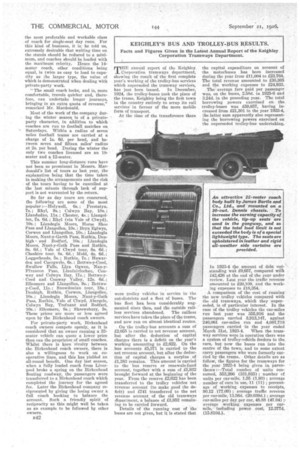KEIGHLEY'S BUS AND TROLLEY-BUS RESULTS.
Page 60

If you've noticed an error in this article please click here to report it so we can fix it.
Facts and Figures Given in the Latest Annual Report of the Keighley Corporation Tramways Department.
rpm] annual report of the Keighley _L Corporation tramways department, showing the result of the first complete year's working of the trolley-bus services which superseded the tramway services, has just been Assued. In December, 1924, the trolley-buses. took the place of the trams, Keighley being the firat town in the country entirely to scrap its rail services in favour of the more mobile form of transport.
At the time of the transference there
were trolley vehicles in service in the out-districts and a fleet of buses. The bus fleet has been considerably augmented since then, and the outside rail less services abandoned. The railless services have taken the place of the trams, and now run on almost identical routes. . On the trolley-bus accounts a sum of £2,055 Is carried to net revenue account, but after the deduction of capital charges there is a deficit an the year's working amounting to £2,622. On the bus accounts £5,371 is carried to the net revenue account, but after the deduction of capital charges a surplus of 11,383 remains. This amount is carried to the bus reserve or renewals-fund account, together with a sum of £5,832 brought forward at the beginning of the year. From the reserve £2,622 has been transferred to the trolley vehicles net revenue account (to make good the deficit) and £741 transferred to the net revenue account of the old tramways depar;:inent, a balance of £3,852 remaining to be carried forward.
Details -of the running cost of the buses are not given, but it is stated that
the capital expenditure on account of the motorbuses has been increased during the year from £11,004 to £23,764. The total revenue amounted to /30,305 and the working expenses to £24,933.
The average fare paid per passenger was, on the buses, 2.58d. in 1925-6 and 3.24d. in the preceding year. The total borrowing powers exercised on the trolley-buses was £59,857, having increased from £21,301 in the year 1923-4, the latter sum apparently also representing the borrowing powers exercised on the superseded trolley-bus undertaking.
In 1923-4 the amount of debt outstanding wa's £9,657, compared with 142,426 at the end of the year under review. Last year the traffic revenue amounted to £20,109, and the working expenses to 118,354.
A comparison of the cost of running the new trolley vehicles compared with the old tramways, which they superseded, is of particular interest. In the case of the trolley vehicles the ear-miles run last year was 355,916 and the passengers carried 3,913,147, against 246,061 car-miles run and 4,087,718 passengers carried in the year ended March 31st, 1923-4. When the. trainwas' services were in operation there was a system of trolley-vehicle feeders to the,. cars, but now the buses run into the centre of the town, and to some extent carry passengers who •were formerly carried by the trains.. Other details are as follow, the figures for the tramways for the year 1923-4 being given in parentheses :-Total number, of units consumed, 553,260 (331,935) ; number ef units per ear-mile, 1.55 (1.80) ; average number of cars in use, 11 (11) ; percentage of working expenses to receipts, 90.12 .(77.09) ; average .traffic revenue per car-mile,-13.56d. (20.039d.) ; average ear-miles per day per car, 48.88 (47.04) ;. average working expenses per carmile, including power cost, 12.3776. (15.810d.).




































































































